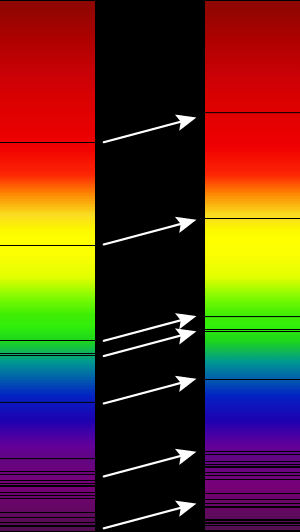Red shift facts for kids
Redshift is a cool way astronomers figure out how far away objects are in the Universe. It's like a cosmic speedometer! Redshift is a type of Doppler effect, which you might have heard about with sound.
What is the Doppler Effect?
Imagine a train coming towards you. The sound it makes seems to get higher in pitch as it gets closer. This is because the sound waves are squished together. As the train moves away, the sound gets lower. The sound waves are stretched out.
The same thing happens with light when objects move very fast. If a star or galaxy is moving towards us, its light waves get squished. This makes the light look a bit more blue than it normally would. This is called blue shift.
If a star or galaxy is moving away from us, its light waves get stretched out. This makes the light look more red. That's why it's called "redshift"! The colors shift towards the red end of the light spectrum.
How Do Astronomers Use Redshift?
Astronomers can tell how much light has shifted because every chemical element, like hydrogen or oxygen, has a special "fingerprint" of light. No two elements have the same one!
They use a tool called a spectroscope to look at the light from a distant object. This tool breaks the light into its different colors, showing these unique "fingerprints" as spectral lines.
By comparing where these lines are to where they should normally be, astronomers can tell if an object is moving towards us or away from us. They can also figure out how fast it's going. The faster an object moves, the more its spectral lines shift from their normal spot.
Images for kids
-
This shows the Doppler effect. A yellow ball (about 575 nm wavelength) looks greenish (blueshift to about 565 nm) as it comes closer. It turns orange (redshift to about 585 nm) as it passes, and then goes back to yellow when it stops moving. To see this color change, the object would need to travel at about 5,200 km/s. That's about 75 times faster than the fastest human-made space probe!
-
This graph shows distance (in giga light-years) versus redshift. The solid black line shows the actual distance from Earth to a place with a certain redshift. The dotted red line shows how long ago the light left that place. The actual distance can be up to 47 billion light-years, which is the size of the observable universe. The "lookback time" (how long light traveled) can be up to 13.8 billion light-years, which is the age of the universe.
-
When matter waves (like protons, electrons, or photons) fall into a gravity well, they gain energy and become blueshifted. This blueshift is the same no matter who is observing it.
See also
 In Spanish: Corrimiento al rojo para niños
In Spanish: Corrimiento al rojo para niños






